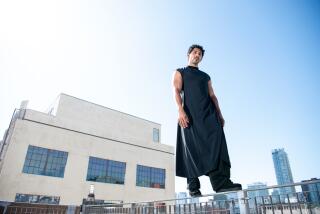Colors, Lines and Prints Make More of a Statement Than Wearer Might Perceive
- Share via
It’s not surprising that fashion designers use many color, line or print illusions to create special effects in their clothing designs. After all, such components affect a body’s proportion and help to create a particular mood.
According to Jane Haxton, a personal shopper at Nordstrom, color, line and print illusions not only leave an emotional impact on the wearer, but on how the wearer is perceived.
“It’s how the wearer communicates,” she says.
Perceptions About Colors
* Black is usually considered sophisticated; however, some may see it as somber and severe.
* Red denotes strength and power. But it also can be thought of as sexy and daring.
* Yellow also denotes strength, but it can put out danger signals. Think of the detour or road work signs alongside the highways. Aren’t they always in yellow and black?
* Brown has the misfortune of a dull reputation. But some shades of brown are considered sophisticated, and will work wonderfully as an accent piece.
* Green may be thought of as sly. (Would you buy a car from a salesman in a bright green suit?) But darker shades such as hunter green, for instance, are considered classy.
Haxton offers the following suggestions:
* When combining colors in an outfit, remember that light values advance and make something seem larger; dark values recede and reduce. A light-colored blouse worn with a dark skirt will make the top seem bigger and hips slimmer.
* Too much color contrast can sometimes create a confusing ensemble that “wears” the wearer, instead of enhancing his or her appearance.
* Used correctly, light/dark contrast can emphasize the positive. For instance, a man’s rugby shirt with a light or bright stripe at the chest will create the illusion of wide shoulders and chest, desirable in a male physique. Vertical stripes on the shirt will emphasize sloping shoulders.
Women with sloping shoulders should avoid garments with raglan sleeves--those with seams slanting from underarm to the neckline. A garment with a set-in sleeve will create the illusion of straighter, wider shoulders.
* An uninterrupted flow of color lengthens and slims. This doesn’t mean a heavy person should forget about contrasting colors or prints altogether, though. Often, a contrasting scarf, tie or shawl, or an outer garment such as a bold print jacket will work with a monochromatic base.
* A horizontal division of color shortens and adds width.
* Big, bold allover plaids and checks shorten the figure and add inches to the hips.
* A skirt with a yoke or one made of horizontal stripes may also emphasize the hips.
* Strong contrasting colors may flatter a person with dark brown hair, fair or olive skin, and dark eyes; however, a person with blond hair, pink/beige skin and light eyes may favor delicate designs and a softer color palette.






